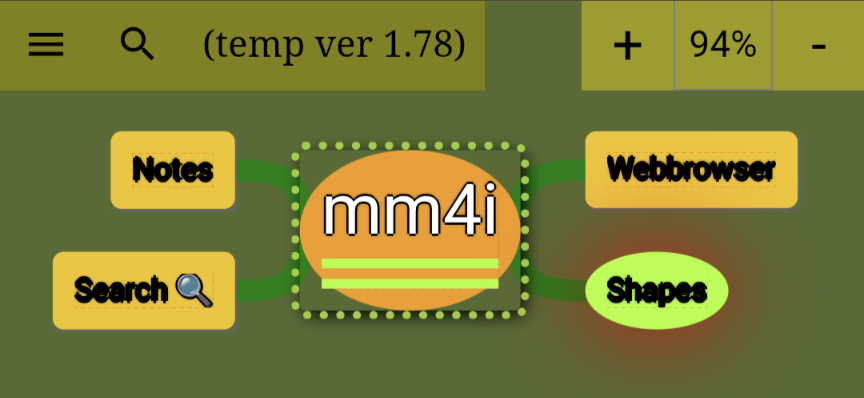mm4i

Mindmaps 4 Internet
MM4I (Mindmaps 4 Internet) is a mindmapping tool accessible directly through your web browser, designed to work both on mobile phones and on desktop computers. You can create and edit mindmaps without needing to install any software, and your work is stored locally for offline use. Key features include the ability to visually enhance nodes, add notes to nodes, search nodes and notes, dynamically link nodes (through the search function), create paths between nodes (called “stairs”), and a visual undo/redo history.
You can start MM4I here:
Usage
Just try it. If you think something needs to be explained then please tell me here.
Hm. Maybe node notes and search needs explanation? Undo/redo style? Backup and sync mindmaps between devices?
Node notes and search links
Each node in a mindmap can have a note that you create. You can search the mindmap for text in node notes (and node topics). And you can create “search links” in your node note that start such a search when clicked.
(To create a “search link” just click the orange search icon in the toolbar when you are editing a node note.)
Undo/Redo (edit history)
There is undo/redo for the mindmap you are editing. However it is visual. It is not bound to keyboard Ctrl-Z as you are used too. Click on the clock symbol in the lower left corner to see the edit history panel.
Linear/tree style for edit history
- Linear: This is what you find in most apps.
- Tree: If you use this style you can create and investigate branches.
Bookmarks for edit history
The edit history panel lets you quickly move between different views of you mindmap subject.
If you find some views more useful you can bookmark them. If you give the bookmarks name they will be there the next time you start editing the mindmap.
Summary mindmap from a link with AI
You can use the major AI:s to get a mindmap from a link. It is like asking the AI for a summary of a link you give it, but you get the summary in the form of a mindmap.
If you install this app it will show up as a share target. Use this to get a summary mindmap.
Sync and Backup
There is currently no built in backup. And the mindmaps are only stored on your device (in your web browser, actually).
So if you loose your device your mindmaps may also be gone.
But there is one possible remedy: You can sync your mindmaps to other devices. (This must be done manually, but I believe it is quite simple.)
Background
Ever since I first saw mindmaps in practical use I have wanted to use it myself. But. It looked like you needed a big paper. Or rather several to redraw the mindmap.
Putting the mindmap in a computer could be a good idea, I thought. And then, preferably the computer I always bring with me, my mobile.
Yes, I know. There are some apps for Android that can do this. But I never install apps from unknown developers because of potential security problems.
There are much less security problem with a web page. And you can actually run a web page like this offline. (You have to “install” it, but for a web app like MM4I the “install” just means that the sources for the web page is cached locally on you device.)
Acknowledgement
First of all I would not have written MM4I (Mindmaps for Internet) if Zhigang Zhang had not written jsmind.
I was looking for mindmap software that ran in the web browser. The only mindmap software I found was jsmind. It ran quite nicely in a web browser on a desktop PC using a mouse. However it did not work in my mobile (Android, of course).
So I thought I should just fix that…
It was far more work than I expected. But also difficult sometimes, which made it more fun.
I strived a bit to make it easy to move nodes in a mindmap. Zhigang (the author of jsmind) came up with a nice idea which I decided to use.
Using a touch screen on a mobile phone instead of a mouse on a desktop can be a challenge for complex interactions. jssm helped a lot when I struggled to implement that.
I did add some things to try to give MM4I the “feel” of a mindmap. Colors, shape etc. And notes for nodes - which I think is a natural addition for a computer based mindmap. (Hm. This gave me a nice lesson on the interaction between JavaScript and the web browser screen renderer. You need to fail before you can learn some things.)
Software included in MM4I:
Software I used when developing MM4I:
My developer notes
Just some links to bugs etc.
